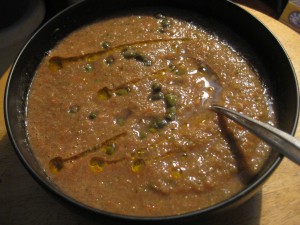 I’ve been on a gazpacho kick lately, since the cold tomato soup is easy to make and excellent summer fare. The other day, I was about to add a couple handfuls of basil to the blender, thinking, “Basil always goes well with tomatoes in Italian dishes.” And then I thought, “Wait, is this Italian or Spanish or something else?” And then I thought, “Man, I really don’t know much about gazpacho.” So I went hunting for some fun gazpacho history, and let me tell you, gazpacho has some murky little secrets it’s been keeping from you.
I’ve been on a gazpacho kick lately, since the cold tomato soup is easy to make and excellent summer fare. The other day, I was about to add a couple handfuls of basil to the blender, thinking, “Basil always goes well with tomatoes in Italian dishes.” And then I thought, “Wait, is this Italian or Spanish or something else?” And then I thought, “Man, I really don’t know much about gazpacho.” So I went hunting for some fun gazpacho history, and let me tell you, gazpacho has some murky little secrets it’s been keeping from you.
Gazpacho is, indeed, Spanish (though arguably Portuguese as well), specifically from the southern Andalusian region of the Iberian Peninsula. And it’s old, really old, though just how old is open to some debate. Some people think it might have its roots in Roman times, based on the fact that the oldest known recipes involve vinegar, and boy, those Romans loved their vinegar. But the more likely story is that the Moors brought over a soup from Morocco when they came to Andalusia around the 8th century, and the Andalusian peasants adopted it as their own since it was the perfect thing to eat while they were working in the fields.
Here’s the crazy part: wherever it came from, that original gazpacho had nary a tomato! It was a paste of garlic, stale bread, olive oil and vinegar, thinned into a soup with water. (A similar dish still exists in Andalusian cuisine, though it’s now called ajo blanco.) They might have added some vegetables and herbs when they were available, but tomatoes, cucumbers and peppers didn’t enter the gazpacho scene until much later, after Columbus brought them back to Europe from the Americas (What up, New World!?).
The name is also cloaked in mystery. Some people say it comes from the Hispano-Roman word for “residue” or “fragments.” Some people say it comes from the Hebrew word for “breaking into pieces.” Some people say it comes from a Greek word for a church collection box (or a place where you would donate little odds and ends to the church). Basically, when it comes to the name, it sounds like people might just be making stuff up.
Today, the most familiar version of gazpacho is the one from Seville, involving tomato, cucumber, bell pepper, vinegar, garlic and stale bread. Every area of Andalusia seems to have its own take, though, throwing in ham or fruit or almonds or hot peppers or whatever strikes their fancy. In fact, what makes it a great dish is probably its elasticity. You can pretty much throw some stuff in the blender, chill it and call it gazpacho. Check out this recent article from the New York Times for ideas.
Here’s my own accidentally-quasi-Italian version, which actually turned out to be quite delicious.
Shannon’s Where-Did-This-Come-From? Gazpacho
Throw into a blender:
- 4 medium tomatoes
- 1 cucumber
- ½ of a red onion
- 3 cloves garlic
- 2 handfuls basil
- 2 slices stale bread
- 2 T. red wine vinegar
- A drizzle of olive oil
- Salt (to taste, but a little bit more than you might usually use, since it will be cold)
Blend until smooth, adding a little water if you want it to be thinner, and then stick it in the refrigerator for a couple hours. Pour it into bowls and garnish with a drizzle of olive oil and some capers.
